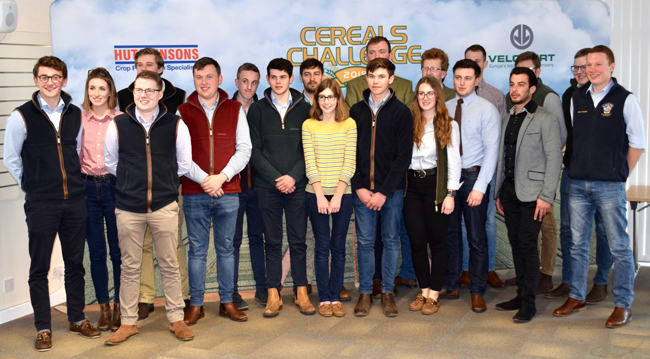Students tackle spring cropping Cereals Challenge
27th February 2019
Author:
Farmers Guide
Students from around the country are competing in the 2019 Cereals Challenge to see which team can grow the best “virtual” crop of spring barley to manage problematic black-grass.
Students from around the country are competing in the 2019 Cereals Challenge to see which team can grow the best “virtual” crop of spring barley to manage problematic black-grass.
It is the 10th anniversary of the competition, organised by crop production specialists Hutchinsons and farm business management company Velcourt, that aims to encourage a new generation of farmers and agronomists into the industry.
Five teams are taking part this year, including students from Writtle University College, Newcastle University, Royal Agricultural University, Riseholme College, and Harper Adams University.
Teams must manage their virtual plot as realistically as possible, taking full responsibility for all aspects of crop management, from cultivation choice to fungicide strategy through the season, as though it were a real crop.
There is a strong environmental focus too, with an additional award and prize money for the team that demonstrates the strongest awareness of environmental protection and integrated pest management (IPM) principles.
The Cereals Challenge provided the ideal opportunity to put academic theory into practice, giving vital hands-on experience to any student pursuing a career in agronomy or arable farming, Hutchinsons services leader Matt Ward said at the launch in Solihull on 20 February.
Successfully managing the complex technical and environmental challenges of the task requires teams to use the raft of information available to develop a clear, integrated crop management plan. As with real-life situations, he said there was no definitive answer, so the key was for students to clearly explain their rationale behind any decisions made.
“Lots of growers are adopting spring cropping to help manage black-grass, but some aren’t necessarily getting the best from these crops in terms of yield or weed control, because they’re not planning what they want to achieve and how they’ll meet these objectives carefully enough.”
To help record and analyse crop management information, all teams have been given access to the Omnia precision farming system for the first time this year.
The system allows them to analyse multiple layers of field data, from soil characteristics and nutrition, to weed pressure and yield potential of the heavy land site, and develop plans to manage in-field variations, through techniques such as variable seed rates.
“In trials we’ve seen up to 1t/ha yield benefit from variable seed rates in spring barley and a reduction in black-grass tillers of 50%, so there are significant benefits to be had if you get it right,” noted Mr Ward.
Teams will be set specific tasks through the season and given regular video updates from Hutchinsons’s technical director Dick Neale and Velcourt’s Matt Cobbald, who will jointly tailor the challenges to reflect actual conditions as the season unfolds.
Mr Cobbald said he was also keen to see how students would use the wealth of information available and distill it down into well thought-out decisions, in the same way an agronomist or technical adviser would do.
“It’s about demonstrating a level of understanding that goes deeper than just providing the right product recommendations. Demonstrating a sound thought process behind decisions is equally important as the end result.”
Establishment planning
The opening task of the Cereals Challenge focussed on establishment, with students asked to plan their approach to seedbed preparation, variety choice, drill choice, drilling date, seed rate, and pre- and post-emergence herbicides.
Each team took a slightly different approach, although it was defending champions RAU, led by Agriculture student Lucy Hando, that took the bold decision to put a low-yielding part of the field close to a watercourse into a grass buffer strip, after using Omnia to analyse field performance and seedbed condition maps.
The rest of the field will be sown early with RGT Planet, using variable seed rates to achieve their target average plant stand of 325/m2.
Writtle College, captained by Harry Jackson, went for the highest target plant population of 375 plants/m2 in an attempt to maximise the “smothering effect” from their crop of direct-drilled Sienna spring malt distilling barley.
“We’ll go with a higher seed rate on turning headlands where we know establishment will be lower and also where weed pressure is higher.”
Black-grass control before drilling, combined with crop suppression of the weed, were priorities for the Harper Adams team, led by Dan Hawes. They opted for the latest drilling date of 1 April, hoping to control more black-grass before the crop of Laureate barley was sown.
“We will treat seed with Turbo [nutrient] dressing to get the crop up and away quickly and hit any emerging weeds early and hard. It will be more expensive, but hopefully worth it if we can reduce the amount of black-grass seed returned for the following crop.”
The winning team will be announced on the Hutchinsons stand at the Cereals Event on 12 June. There will be a trophy and total prize money of £1,000 for the winners, plus £500 for the College or University they represent.
An additional prize of £400 will go to the winning team of the environmental part of the competition, plus £100 for their College or University.
Follow progress from all teams taking part in the 2019 Cereals Challenge and view video updates from the plots on Twitter using #CerealsChallenge2019



